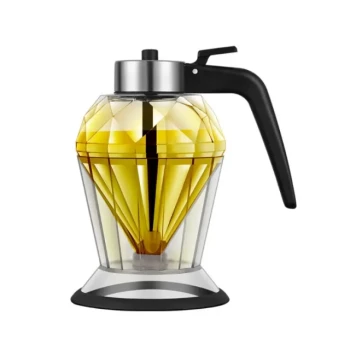Honey dehumidifiers are essential tools for beekeepers aiming to maintain optimal honey quality by controlling moisture levels. Our range includes machines suitable for both small and large-scale operations. Products like the Economy Small Scale Honey Dryer and the Honey Concentrating and Filtering Dehumidifier Machine 2T Capacity cater to diverse needs, ensuring efficiency and durability. Whether you’re processing honey in a small apiary or a large facility, our honey dehumidifiers offer reliable performance and ease of use.
Toggle Categories
Get Instant Support
Choose your preferred way to connect with our team
-
Get Free Quote Fill out form for detailed pricing
-
Send Email Detailed inquiry support
-
WhatsApp Quick mobile chat
Response Time
Within 8 hours on working days, 24 hours on holidays
honey dehumidifier

High Quality Honey Dehumidifier Dryer Thickening Machine for Beekeeping
Item Number : HD-1

Economy Small Scale Honey Dryer Dehumidifier Thickening Machine
Item Number : HD-2

Honey Concentrating and Filtering Dehumidifier Machine 2T Capacity for Honey
Item Number : HD-6

Honey Concentrating Vacuum Heating Thickening Machine Dehumidifier for Honey
Item Number : HD-3

Premium Diamond-Faceted Glass Honey Dispenser
Item Number : AHS-2
Why Choose Our Honey Dehumidifiers?
Our honey dehumidifiers are engineered to meet the highest standards of quality and efficiency, ensuring that your honey retains its natural goodness while achieving the desired moisture content. Here’s a detailed look at what makes our products stand out:
Advanced Technology for Optimal Performance
Our honey dehumidifiers incorporate advanced vacuum heating and thickening technologies, which work together to reduce moisture content effectively. This not only enhances the quality of your honey but also extends its shelf life. The adjustable temperature controls allow you to fine-tune the drying process according to your specific requirements.
Durable and Hygienic Construction
Constructed from high-grade 304 stainless steel, our machines are built to last. The materials used are resistant to corrosion and easy to clean, ensuring that your honey remains free from contaminants. This durability makes our dehumidifiers a cost-effective investment for both small-scale beekeepers and large-scale honey processors.
Versatile and Scalable Solutions
We offer a wide range of honey dehumidifiers to cater to different scales of operation. From the Economy Small Scale Honey Dryer, perfect for small apiaries, to the Honey Concentrating and Filtering Dehumidifier Machine with a 2T capacity, designed for large-scale facilities, our products are versatile and scalable. This ensures that you can find the right machine to meet your specific needs.
Efficient Moisture Control
Maintaining low humidity in your honey house is crucial for preventing the hatching of small hive beetle (SHB) eggs and ensuring that your honey supers are processed before infestations occur. Our dehumidifiers help create a controlled environment, allowing you to manage moisture levels effectively. By stirring the honey several times a day, you can further reduce its moisture content, ensuring a high-quality final product.
Easy to Use and Maintain
Our honey dehumidifiers are designed with user-friendliness in mind. The intuitive controls and straightforward maintenance procedures make these machines easy to operate, even for those new to beekeeping. Regular maintenance is simple, ensuring that your machine remains in top condition for years to come.
Customizable Options
We understand that every beekeeping operation is unique. That’s why we offer customizable options to tailor our honey dehumidifiers to your specific requirements. Whether you need a machine with a particular capacity or specific features, our team is here to help you find the perfect solution.
Industry Compliance and Reliability
Our honey dehumidifiers are designed to comply with industry standards, ensuring that your honey processing meets all necessary regulations. The reliability of our machines means you can focus on producing high-quality honey without worrying about equipment failures.
Why Invest in a Honey Dehumidifier?
Investing in a honey dehumidifier is a smart move for any beekeeper looking to enhance the quality of their honey. By controlling moisture levels, you can prevent issues such as fermentation and spoilage, ensuring that your honey remains fresh and marketable. Additionally, the ability to process honey supers quickly helps prevent infestations, saving you time and money in the long run.
Ready to Elevate Your Honey Production?
If you’re ready to take your honey production to the next level, our honey dehumidifiers are here to help. With advanced technology, durable construction, and customizable options, our machines are designed to meet the needs of beekeepers of all scales. Contact us today to learn more about our products and how we can help you achieve your honey processing goals. Leave us a message to get started!
FAQ
What Is The Application Of A Honey Dehumidifier?
How Does A Honey Dehumidifier Work?
What Are The Advantages Of Using A Honey Dehumidifier?
What Types Of Honey Dehumidifiers Are Available?
Why Is It Important To Control Humidity In Honey Processing?
REQUEST A QUOTE
Our professional team will reply to you within one business day. Please feel free to contact us!
Related Articles

Optimizing Beehive Entrance Discs: When Freedom Boosts Hive Performance
Learn how optimizing beehive entrance discs boosts hive performance by enhancing foraging, ventilation, and security with seasonal adjustments.

The Precision Imperative: Why a 30-Second Calibration Prevents a Costly Harvest Failure
Uncalibrated refractometers risk your honey harvest. Learn why this 30-second step is crucial for preventing fermentation and financial loss.

Galvanized vs. Stainless Steel Queen Excluders: A Data-Backed Guide to Long-Term Durability and Cost Efficiency
Compare galvanized vs. stainless steel queen excluders for durability, cost efficiency, and hive compatibility. Choose the best for your beekeeping needs.

Beyond the Embosser: The Systems Thinking Behind Perfect Beeswax Foundation
A beeswax foundation machine is a system, not a single device. Understanding its components is key to scaling production from manual craft to commercial consistency.

From Liquid to Lattice: Mastering Thermal Control in Beeswax Foundation Stacking
Discover how proper beeswax sheet stacking is a critical thermal management process, not just storage, to ensure high-quality, defect-free foundation.

The Last Gate: Why a Simple Strainer Defines Honey Quality at Any Scale
Discover why the humble honey strainer is a non-negotiable tool for beekeepers, ensuring honey purity and quality at every scale of operation.

How Queen Excluders Optimize Hive Productivity: Benefits, Limitations & Advanced Techniques
Learn how queen excluders optimize hive productivity, their benefits, limitations, and advanced techniques for beekeepers.

Why Your Milled Beeswax Foundations Warp—And How to Fix It for Good
Struggling with warped beeswax foundations? Discover the true cause isn't your mill and learn the simple, reliable fix for consistently perfect results.

The Bottleneck in the Honey House: Choosing an Uncapping Tool is a Workflow Decision, Not a Purchase
Choosing an uncapping tool—electric vs. manual—is a critical workflow decision that impacts an apiary's efficiency, cost, and honey quality.

Beyond the Bee Box: Why Your First Apiary Investment Determines Your Success
Discover the root cause of first-year hive failure. Learn why cheap starter kits often fail and how professional-grade equipment ensures apiary growth and profitability.

How to Purify Beeswax Contaminated with Brood Comb: Maximizing Honey Recovery
Learn advanced beeswax purification techniques for contaminated brood comb, maximizing honey recovery with solar melters and water baths.

Engineering the Harvest: The Counterintuitive Logic of the 9-Frame Super
Learn why using 9 frames in a 10-frame hive leverages bee psychology to create fatter combs, simplifying honey harvesting and boosting efficiency.

The Extractor's Edge: Why Preserving Comb is the Key to Apiary Profitability
Explore the critical tradeoff between honey extraction methods. Learn why preserving comb with centrifugal extractors maximizes long-term productivity.

Why Your Bees Reject Plastic Foundation—And How to Guarantee Acceptance
Frustrated by bees ignoring your plastic foundation? Learn the biological reason why and the simple, two-part strategy to ensure rapid comb drawing.

The Last Drop: Maximizing Yield and Purity with a Stainless Steel Honey Press
A honey press isn't just an extractor; it's a tool to reclaim value from wax cappings, ensuring purity with food-grade steel and solder-free welds.

How to Clean Beeswax Properly: A Step-by-Step Guide to Preserving Quality
Learn step-by-step methods to clean beeswax safely, remove impurities, and preserve quality for beekeeping and crafting. Avoid common pitfalls.

How Queen Excluder Materials Shape Hive Health and Honey Yields
Compare plastic vs. metal queen excluders for bee health, climate resilience & cost efficiency. Make informed choices for sustainable beekeeping.

How Jenter and Nicot Systems Revolutionize Queen Rearing Efficiency
Discover how Jenter and Nicot systems boost queen-rearing efficiency with graft-free technology, higher success rates, and labor savings for beekeepers.

How Stored Honey Frames Accelerate Colony Recovery: A Beekeeper’s Guide
Learn how stored honey frames boost spring colony recovery with science-backed strategies for beekeepers. Enhance survival & brood production.

How to Optimize Queen Excluder Placement for Healthier Hives and Higher Honey Yields
Learn how to optimize queen excluder placement for healthier hives and higher honey yields with expert beekeeping tips.
